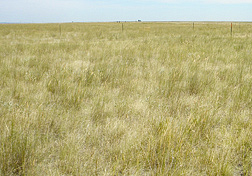This page has been archived and is being provided for reference purposes only. The page is no longer being updated, and therefore, links on the page may be invalid.
| Read the magazine story to find out more. |
|
|
|
|
Using Fire to Keep Rangelands Viable for Grazing
By Dennis O'Brien
April 24, 2014
U.S. Department of Agriculture (USDA) researchers are looking for ways to use "prescribed fire" to control a weed that is colonizing disturbed soils and overtaking western grazing land. When fully grown, the weed, called purple threeawn, has sharp prongs that make it undesirable to cattle. When cattle have no other choices and are forced to eat purple threeawn as a staple of their diet, they fail to thrive.
Range ecologist Lance Vermeire and range technician Dustin Strong, with the USDA's Agricultural Research Service (ARS) in Miles City, Montana, wanted to determine whether fire could reduce the abundance of purple threeawn and create more balanced ecosystems. ARS is USDA's principal intramural scientific research agency, and this research supports the USDA priority of promoting international food security.
Carefully staged "prescribed fire" can reset a rangeland's biological clock, breathe new life into an ecosystem, and give perennial, sod-forming grasses that are good sources of forage a better chance to take hold.
A key question is when to use fire. Most prescribed fires are set in rangelands during spring or fall, but a plant's response to fire varies with its stage of development and activity level. Most native grasses in Montana are cool-season plants that have adapted to the natural cycle of frequent summer wildfires. They go dormant in the summer, making them less susceptible to summer fires. Purple threeawn, however, is a warm-season species that grows during the summer, which should make it more susceptible to summer fires.
In a study at two Montana sites, plots were either burned during the summer or fall or were not burned at all, and each of those treatments had either no nitrogen fertilizer or one of two levels of added nitrogen. Precipitation levels varied widely: The spring of 2011 saw record rainfall, but the spring of 2012 was one of the driest on record.
The results showed that while fall fires did reduce purple threeawn production, summer fires were much more effective, particularly after a wet spring. In comparison to the control plots, the weed's overall biomass was reduced 90 percent by the summer fire and 73 percent by the fall fire after the wet spring, and 73 percent by the summer fire and 58 percent by the fall fire after the dry spring.
The results were published in Rangeland Ecology and Management and in Fire Ecology in 2013.
Read more about this research in the April 2014 issue of Agricultural Research magazine.

